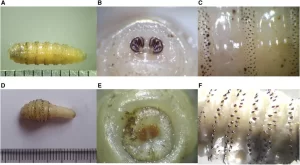Myiasis classification, diagnosis, causes, treatment and medicolegal importance
Myiasis
Flies Causing Myiasis can be classified into:
- Coloured flies: e.g. Lucilia, Calliphora, Cordylobia, and Dermatobia.
- Non-coloured flies: e.g. Musca (house fly) and Sarcophaga.
Classification of Myiasis
Myiasis is classified according to the biological habits of the fly or according to the site of tissue invaded.
According to the Biological Habits of the Adult Fly:
1. Specific or Obligatory Myiasis
This is the condition when the fly larvae are obligatory tissue parasites and can only develop on or in living tissues, Female flies deposit their eggs on dry soil or sand in shady places; especially those contaminated with human urine or excreta. Adult flies can also lay their eggs on soiled clothes or clothes that were left to dry outdoors.
Once these clothes are worn without ironing, eggs hatch, and the larvae, aided by their powerful oral hooks, bury themselves completely under the skin except for their posterior spiracles (respiratory openings) causing boil-like swellings (furuncular myiasis), Examples: Cordylobia and Dermatobia flies.
2. Semi-specific or Facultative Myiasis
This group includes flies in which their larvae can complete their development without a host. They habitually oviposit or larviposit on dead bodies of man or animals. However, they can develop in a host if entry is facilitated by the presence of a wound or ulcer, which is secondary infected since they are attracted by the offensive discharges coming from these neglected wounds.
They are also attracted to inflamed ears and eyes. Thus, deposit their larvae or eggs in such tissues. The presence of larvae prevents healing and induces sepsis in the affected sites. Examples: Sarcophaga, Calliphora, and Lucillia flies.
3. Accidental Myiasis
Accidental myiasis occurs when fly eggs or larvae are deposited on food material such as cheese and vegetables and these are then accidentally ingested leading to intestinal myiasis. Moreover, when the eggs are deposited around the anal canal or urogenital orifice the larvae can travel up these passages leading to intestinal or urogenital myiasis respectively. Examples: Musca domestica fly.
According to the Site of Tissue Invaded: Different tissues may be invaded and thus we may find the following kinds of myiasis.
1. Internal Myiasis
a. Intestinal Myiasis: Several flies may deposit their eggs or larvae on human food or on the anus during sleep or defecation in open latrines (particularly in children living in rural areas). Larvae find their way to the intestine and may cause nausea, vomiting, abdominal discomfort, or pain with diarrhea.
When larvae are accidentally ingested, intestinal myiasis is facilitated by lowered gastric acidity. Living and dead larvae may appear in stools or vomitus. Example: Musca domestica fly.
b. Urogenital Myiasis: Larvae may enter through urinary or genital orifices or through lesions on these orifices. They may cause inflammation with pus, mucous, and blood in the urine. Obstruction to the urine flow with pain can occur. The maggots (larvae) passed in urine are used for diagnosis of the species of the invading fly.
2. External Myiasis
a. Cutaneous Myiasis: Cutaneous myiasis can occur by two ways:
i. Invasion of Wounds or Ulcers
Traumatic (Wound) myiasis occurs when wounds or ulcers are invaded by larvae of flies, which would usually lay their larvae or eggs in decaying flesh of dead animals and accidentally deposit their eggs or larvae in neglected sores or wounds. These larvae may cause extensive damage by burrowing deeply into the wound.
As they feed on the wound, they increase in size and cause tissue destruction. Larvae reach maturity in about a week then they leave the wound, fall to the ground into which they burrow, and then pupate, Examples: (Sarcophaga, Calliphora, and Lucilia flies.
ii. Invasion of Intact Skin
Furuncular Myiasis: Larvae (mainly of Cordylobia and Dermatobia flies) may invade hair follicles and produce furuncular swellings. Symptoms of this infestation include itching in the first two days which subsides and is replaced by more severe pain as the larva grows and becomes active in the boil-like swelling.
Serous fluid exudes from the lesion and the posterior end of the larva can sometimes be seen. Infestation can occur anywhere on the skin surface, scalp, arms, and shoulders. Examples: Cordylabia and Dermatobias.
Creeping (Migratory) Myiasis: Larvae may accidentally invade the unbroken skin of the unnatural host and wander in the dermal tissue forming serpentine-like lesions with papules and pustules.
b. Ocular Myiasis
Larvae of several species of flies may find their way to the conjunctiva and may reach the brain. Severe pain in the eye is the first complaint in ocular myiasis. Larvae can cause conjunctivitis, corneal ulcers, or even panophthalmitis.
c. Nasopharyngeal Myiasis
Larvae find their way to the nose and may reach the brain. In the nose, they cause obstruction and a persistent bloody purulent discharge.
d. Aural Myiasis
Purulent exudates discharged from running ears attract flies and they deposit their eggs or larvae there and cause otitis externa, Later, larvae invade the middle ear, inner ear, or even mastoid sinuses or the brain tissue in extreme cases.
Ocular, nasopharyngeal, or aural myiasis are considered as semi-specific (facultative) myiasis if the flies are attracted to offensive inflammatory discharges in these sites. However, if the larvae of adult flies invaded healthy, non-inflamed eyes, nose, and ears, the type of myiasis in these cases is considered specific (obligatory) myiasis.
Diagnosis of Myiasis
It can be made only upon finding the larvae of higher Diptera (maggots) which should be removed and examined for identification.
Treatment of Myiasis
- Removal of the larvae and then treatment of the lesion. This is easy if the larvae are in open wounds.
- If the larvae are deeply seated, an attempt must be made to remove the larvae surgically and the wound should be packed with an antibiotic.
- Larvae in furuncles can be stimulated to leave by occlusion of the opening with Vaseline (petroleum jelly) to prevent their respiration.
- Larvae in wounds or body openings can be removed by applying a gauze pad soaked in chloroform or ether or by irrigation of the area with 5-10% chloroform in light vegetable oil, to paralyze the larvae.
Prevention and Control
1. Eradication of the fly population and their breeding places by suitable insecticides
2. Avoidance of infestation by taking the following precautions:
- Iron clothing was left to dry outside, so as to kill eggs deposited by flies.
- Do not allow children to sleep exposed outdoors.
- Cover wounds with clean, sterile dressings to prevent their infestation by maggots.
- Protect and wash food stuff to prevent accidental ingestion of larvae.
- Use nets, screens, and repellents.
Although larvae of higher Diptera are considered as harmful parasites, they can be of benefit to man. This can be in two aspects: Maggot therapy and Medicolegal aspects.
Maggot Therapy
In World War 1, and before the era of antibiotics, soldiers with maggot-infested wounds were noticed to get better faster than others. Being voracious feeders of necrotic tissues, larvae of Lucilia flies were introduced by surgeons into the wounds to enhance wound debridement and healing, Nowadays, readymade dressings and topical applications containing larval extracts are used instead of live maggots.
Medicolegal Importance
The presence of the larvae in dead bodies can be a clue to the time of death. The longer the larvae, the older it is. Thus, by measuring the size of the larvae, the approximate time of death can be estimated.
You can follow science online on YouTube from this link: Science online
You can download Science Online application on Google Play from this link: Science online Apps on Google Play
Medical entomology, Arthropods types, Toxaemia, Scorpion sting, Mosquito dermatitis & scabies
Importance & types of fungi, Opportunistic infections & Predisposing factors to candidosis
Vaccines types, Live vaccines, Inactivated vaccines, Subunit vaccines, Naked DNA & mRNA vaccines
Features and classification of viruses, Defective viruses & Viral vectors used for gene therapy




